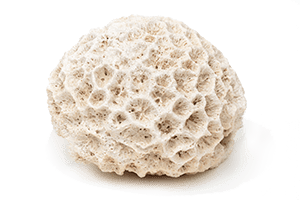Molybdenum is an essential trace mineral and in samples of stony corals was found at the level of less than 0.08 ppm. These trace minerals are key components in three important metalloenzyme systems, xanthine oxidase, aldehyde oxidase, and sulfite oxidase. The average adult has 9 mg of molybdenum in the body, most of it concentrated in the liver, adrenal glands, kidneys, bones and skin. (Halstead) Food sources include milk and other dairy products, dried legume and organ meats and whole grains. (Cichoke)
These trace minerals benefits the body in the detoxification of alcohol and sulfites and in the formation of uric acid, a byproduct of protein metabolism. (Bergner) This makes molybdenum important in modern life because sulfites are listed as GRAS by the FDA and used as food preservatives in many processed foods or to prevent fresh restaurant foods from browning. Reactions to sulfites can include acute asthma attacks, anaphylactic shock, diarrhea and nausea soon after ingesting sulfiting agents. (Winter)
It’s almost impossible to become deficient in molybdenum when eating normal nutritional diets. (Mervyn) Indications of deficiency in humans are irritability, irregular heartbeat, and lack of uric acid production. Deficiency is almost always due to prolonged parenteral nutrition, (ingestion of nutrition other than through the digestion system).
The Complete Book of Enzyme Therapy, Anthony J. Chichoke, page 62.
The Dictionary of Minerals, Leonard Mervyn, pages 134-135.
Dorland’s Illustrated Medical Dictionary, 27th Edition, page 1326.
A Consumer’s Dictionary of Food Additives, Ruth Winter, page 281, 397.
Fossil Stony Coral Minerals, Bruce W. Halstead, page 75.
The Healing Power of Minerals, Paul Bergner, pages 166-168.
The Merck Manual, Fifteenth Edition, page 950.
